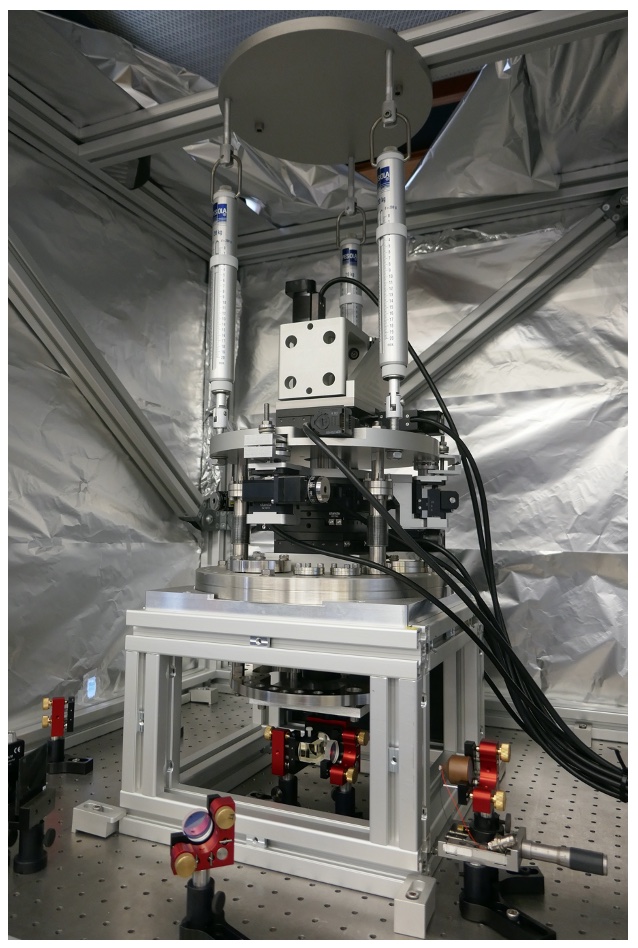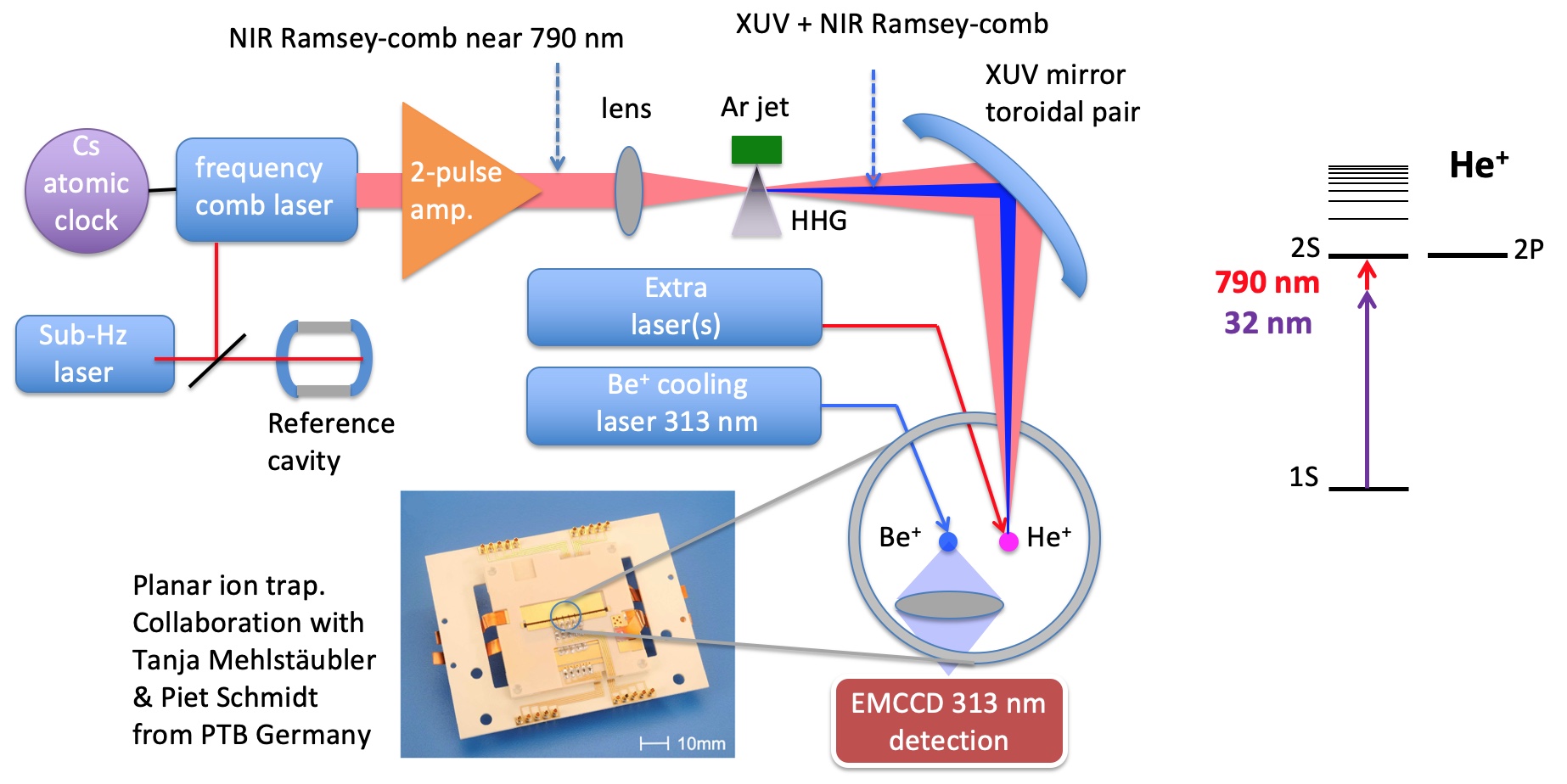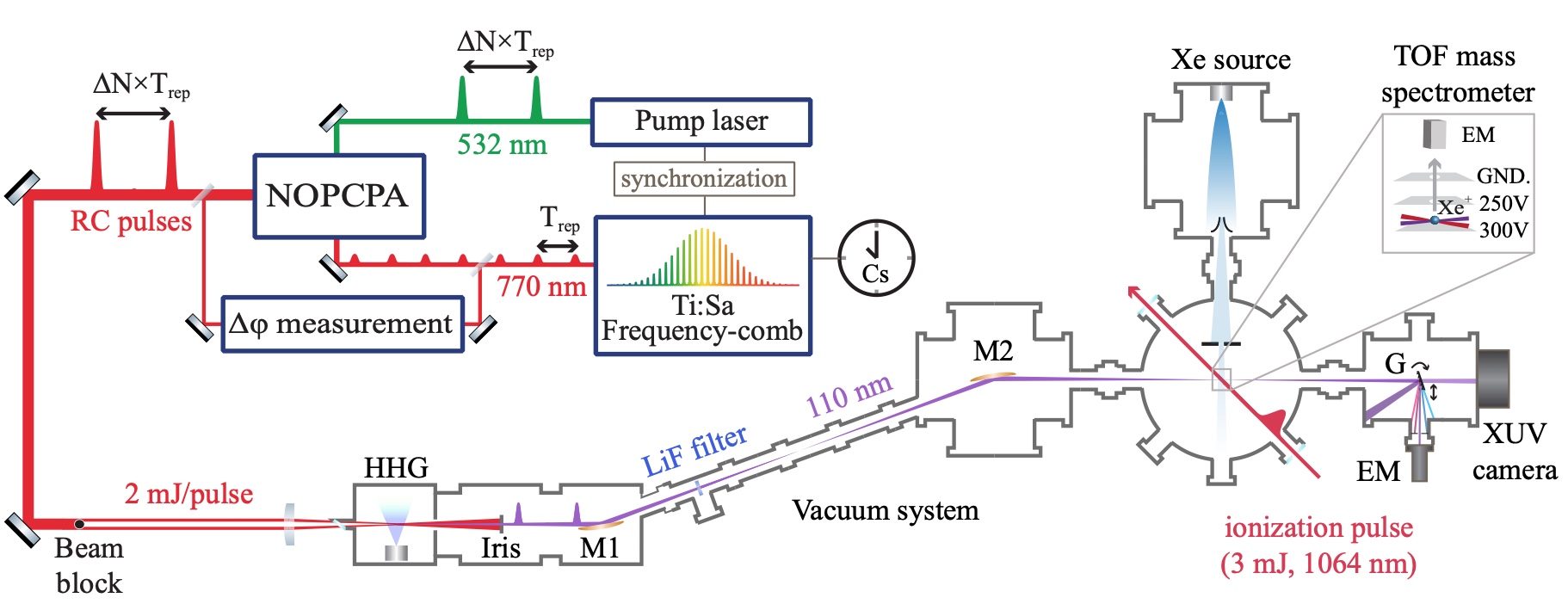
 |
|
 |
THIS WEB PAGE WILL VERY SOON BE UPDATED WITH OUR LATEST
RESULT ON 1S-2S EXCITATION of HE+ IN AN ATOMIC BEAM,
PUBLISHED IN COMMUNICATIONS PHYSICS 2024.
1S-2S spectroscopy of trapped
singly-ionized helium
One way to find new clues for possible new physics is to test QED & nuclear size influences in different systems, such as Helium+ ions. The CREMA collaboration has measured the 2S-2P transition in muonic helium+ ions (both 3He and 4He), and evaluation of the results is in progress. What we like to do is to measure the 1S-2S transition in normal helium+ for the first time so that it can be compared to the muonic helium+ measurements. In combination with the measurements in atomic hydrogen, this could lead to a better test of (higher-order) QED, or it can be used to check the value of the Rydberg constant, or to determine a more accurate charge radius of the alpha particle (the nucleus of Helium+). In a paper we wrote in 2019 (which you can find here) we explain in more detail what we can learn from He+ spectroscopy, and how we intend to do it. We are now building the setup to realize 1S-2S excitation of He+ trapped in a linear Paul trap, with a co-trapped Be+ ion for sympathetic cooling (1 mK by Doppler cooling, or below by side-band cooling). Spectroscopy will be performed with our Ramsey-comb method [7-9] that combines high-energy (mJ-level) phase-stable ultrafast laser pulses with kHz or better frequency precision. We will use a combination of 32 nm made by high-harmonic generation from 790 nm, and the 790 nm itself, for the two-photon transition to enhance the transition rate compared to the more obvious equal-photon scheme (2x60 nm). In the next section we describe the first demonstration of Ramsey-comb spectroscopy in xenon using high-harmonic generation. This demonstrates that Ramsey-comb spectroscopy works very well with HHG, which is a vital step towards our plans for measuring the 1S-2S He+ transition. For ion trapping technology we work together with dr. Tanja Mehlstaeubler and prof. Piet Schmidt of the PTB Braunschweig, Germany, and we are currently setting up an advanced ion trap for He+ with their help. |
|
||||||
Towards 1S-2S He+ spectroscopyWe have converted the setup shown above to the 1S-2S He+ experiment and are adding a lot of hardware, electronics and software. In the beginning of 2020 a new ion trap was made that will be used to trap He+ and Be+ (for sympathetic cooling). The trap itself was designed and made by Elmer Grundeman, with generous help and based on previous designs from the group of prof. Tanja Mehlstaeubler at the PTB in Germany. In fact, Elmer went to PTB to use their facilities to put the trap together.Below on the left you can see a photo of the trap still wrapped in protective foil just after it arrived in our lab in Amsterdam. On the right you see the special trap-mounting construction that will house the ion-trap. It enables alignment of the trap in all degrees of freedom (designed and built by Julian Krauth) and in the picture it is mounted in an interferometric test-setup for stability measurements. Note for Master and Bachelor students: on several aspects of this project we can define projects. Please contact Kjeld Eikema at k.s.e.eikema@vu.nl |
||||||
  |
||||||
| Below: parts of the
new Ramsey-comb laser system (no. 2) designed for
He+ excitation near 30 nm with extra low phase
noise. This system, built and designed by Mathieu
Colombon and Charlaine Roth,
uses as a starting point a commercial (Menlo
Systems) ultra-stable frequency comb laser system
(ULN, doubled Er-fiber) that is stabilized to a
sub-Hz ultra-stable laser (also Menlo) and a Cs
atomic clock. The parts shown below are different
components of the new pump laser for the
parametric amplifier of the comb laser pulses. |
||||||
 |
| References: [1] C.G. Parthey et al., PRL 107, 203001 (2011) [2] R. Pohl et al, Nature, vol. 466, pp. 213-216 (2010) [3] A. Antognini, et. al., Science 339, 417-420 (2013) [4] R. Pohl et al., Science 353, 669-673 (2016) [5] A. Beyer et al., Science 358, 79-85 (2017) [6] H. Fleurbaey et al., ArXiv 1801.08816v1 (January 2018) [7] J. Morgenweg, I. Barmes, K.S.E. Eikema, Nature Physics 10, 30-33 (2014) [8] J. Morgenweg, K.S.E. Eikema, Phys. Rev. A 89, 052510 (2014) [9] R.K. Altmann, S. Galtier, L.S. Dreissen, and K.S.E. Eikema, Phys. Rev. Lett. 117, 173201 (2016) [10] J. Liu et al., J. Chem Phys. 130, 174306 (2009) |
We gratefully acknowledge
financial support from the following organizations:
 |
 |
 |
 |
Questions? Contact: k.s.e.eikema@vu.nl

